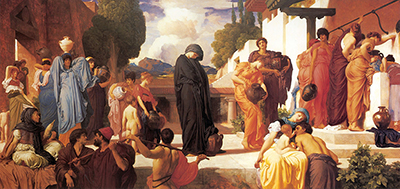Frederic Leighton was a 19th-century British painter and sculptor. Many of his works involve the use of biblical, historical and classical subjects. One of his classical works was the painting titled Captive Andromache.
In 1888 Leighton created the artwork known as Captive Andromache. It is a large oil on canvas painting that measures 197cm high and 407cm wide. The main subject in the picture is Andromache. She was the wife of Hector, one of the heroes of the Trojan War. There is a belief that the painting represents the view Hector has about his wife's fate should he die. Although painted in 1888, Leighton began work in 1886 by preparing many detailed sketches and tracings of the subject. As the painting was not the result of a commission, Leighton sold the picture in 1889 to Manchester City Council. Today, it’s on display to the public in the Manchester Art Gallery. It hangs there along with several preparatory studies for the work.
The painting, Captive Andromache shows a classical Greek scene. Andromache is standing in the centre of the picture on a raised stone walkway. Behind her, there is a distant mountainous landscape and cloudy sky. As part of the background, on the right are white stone buildings, while to the left are dark stone buildings. There are trees next to each building which frames the distant mountain landscape. In what is a crowded scene, Andromache appears alone and isolated from those around her. She is dressed in black with her head bowed in sorrow. Around her, the people appear arranged in a way that they flow from left to right. The women and girls on the raised stone walkway are carrying Greek-style water jugs. They are moving a line towards the right of the picture to collect water from a well.
Along the front of the raised walkway are men, women and children. In the bottom right of the picture is a small family group consisting of a mother, child and father. Andromache is looking thoughtfully down at this group. On the opposite side is an old woman sitting down and spinning. The woman is gazing up at Andromache. Additionally, there are three men carrying staffs standing in front of the raised walkway. Leighton's painting style in Captive Andromache involves the appearance of flow. To achieve this, Leighton's uses two techniques. The first is the placement of the people in the scene. On the walkway, the people appear almost in a single line with Andromache at the centre. The other is how Leighton uses colour. In the picture, the colour transitions like a wave. The colour appears cold and dark on the left side of the picture, becoming warmer moving to the right.




